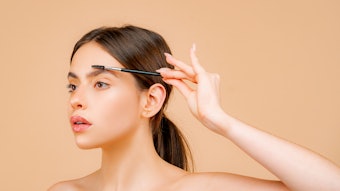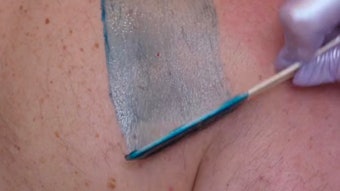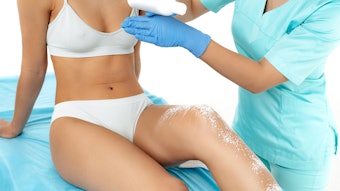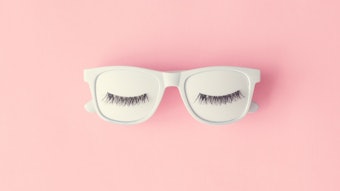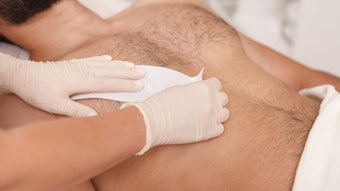
There is a myth going around among clients 30 and over that waxing causes wrinkles. These clients have become hesitant to wax the more delicate areas of the face for fear that it will cause wrinkling, especially around the eyes. This is a myth that needs to be stopped in its tracks.
Wrinkles themselves are a mystery to most people. From the client’s perspective, they appear as if by magic. One day they go to bed with perfect skin, and the next day they wake up with wrinkles. As professionals, we understand that these things don’t just happen overnight. The harsh reality is that wrinkles begin forming at an early age, due to an abundance of factors (none of which is waxing), and it takes years for those wrinkles to reveal themselves.
Wrinkles are prone to be more visible on areas such as the lip and brow because the skin is thinner, more delicate and exposed to the elements (sun and pollution), which are major causes for wrinkling. Therefore, these areas will naturally lose their elasticity quicker than the thicker skinned areas of the body, like the arms and legs.
As technicians, it is our responsibility to educate our clients on what does and does not cause wrinkles, so that they can continue to wax with confidence. Before this article gets into the actual causes of wrinkles, it will dispell why wrinkles likely aren’t one of them.
Waxing and Wrinkles
Most clients who believe that waxing causes wrinkles have been told that the stretching and pulling of skin during waxing can lead to wrinkles. There are two main reasons this is not true: proper technique and waxing frequency.
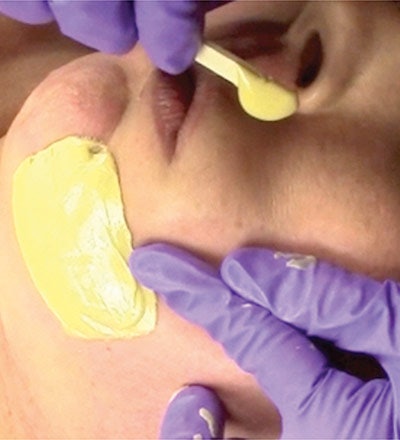 Proper technique. To prevent damage to the skin and its underlying structures, it is important to use proper technique. The skin should be held taut on both application and removal of the wax. If skin is not held taut during application, it will not “shrink wrap” properly to remove the hair cleanly, which can lead to repeated application over the same area and an increased chance of damaging the skin. Additionally, when the skin is not held taut on application, it creates a pull and drag under the stick as the wax is applied, which might cause the skin to become more lax in the long run.
Proper technique. To prevent damage to the skin and its underlying structures, it is important to use proper technique. The skin should be held taut on both application and removal of the wax. If skin is not held taut during application, it will not “shrink wrap” properly to remove the hair cleanly, which can lead to repeated application over the same area and an increased chance of damaging the skin. Additionally, when the skin is not held taut on application, it creates a pull and drag under the stick as the wax is applied, which might cause the skin to become more lax in the long run.My go-to wax for the delicate areas of the face is hard wax. Hard wax is more gentle than strip wax; it “shrink wraps” around the hair to remove it without sticking to the skin, whereas strip wax adheres to both the hair and skin. This is important because less stress is placed on the skin, reducing unnecessary pulling on the skin. Because strip wax sticks to both hair and skin, the skin might “bounce back” as the strip is removed, which could lead to damage of the underlying tissue resulting in bruising or lifting of the skin. The skin should also be held taut during removal of the wax. It is important to remove the wax with a hand parallel and close to the skin so that the skin is not pulled in an upward direction on removal to again keep the structure of the skin underneath intact.
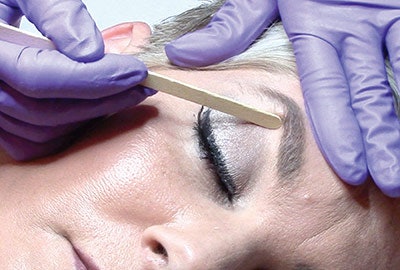 Even though hard wax doesn’t stick to the skin, it can still create that “bounce back” if skin is not held taut and the hand is not kept parallel to the skin on removal. When removing wax around the eyes and lips, keep the skin taut all along the removal path by taking shorter pulls to remove the wax, adjusting your hand after each pull to keep the skin taut. This will help protect the skin from “bouncing back” and damaging the underlying structures.
Even though hard wax doesn’t stick to the skin, it can still create that “bounce back” if skin is not held taut and the hand is not kept parallel to the skin on removal. When removing wax around the eyes and lips, keep the skin taut all along the removal path by taking shorter pulls to remove the wax, adjusting your hand after each pull to keep the skin taut. This will help protect the skin from “bouncing back” and damaging the underlying structures.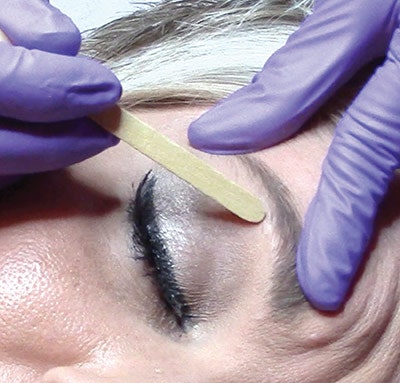 Both technical errors create a lifting of the underlying structure of the skin that over time (a long time) may weaken the muscle, causing it to be more lax, but this is highly unlikely. Keep stretching and pulling of the skin to a minimum during waxing by choosing the right products for the delicate facial area and using the best techniques to prevent damage to the skin.
Both technical errors create a lifting of the underlying structure of the skin that over time (a long time) may weaken the muscle, causing it to be more lax, but this is highly unlikely. Keep stretching and pulling of the skin to a minimum during waxing by choosing the right products for the delicate facial area and using the best techniques to prevent damage to the skin.Infrequency. Waxing is not something that clients do on a daily basis. Most clients are on a schedule of waxing their lip and brows once every 3-6 weeks. If clients were to have these areas waxed on a daily basis, the simple act of the minimal stretching required to keep the skin taut on application and removal of the wax may lead to making the skin more lax.
Facial expressions. Another reason that waxing does not cause wrinkles is that it doesn’t require repeated facial expressions. Facial expressions help to “etch” in certain lines and wrinkles under the skin. Waxing does not require the client to make any of these types of expression while being waxed, so there is no chance that they are creating future lines.
Skin movement. Also, there should be no skin movement during the waxing process, such as rubbing or scrubbing. Repeated aggressive skin movement during makeup removal has been shown to lead to wrinkles, as described below.
Wrinkle Causes
Now that we’ve covered why waxing doesn’t cause wrinkles, let’s tackle what elements actually do cause wrinkles.
Intrinsic aging. The human body naturally ages, and with this aging comes the slowing of many of the body’s processes and a breakdown of structural support in the skin. The skin naturally loses collagen, elastin and moisture, which are the mainstays that help to keep skin firm and resilient. As these components decrease, fine lines and wrinkles become more visible. Most people will begin to notice the effects of intrinsic aging in their early to mid-30s, so it is no wonder why this age group starts to be concerned about activities that might exacerbate wrinkle formation.
Extrinsic aging. This is skin aging caused by factors outside the body that come in contact with the body. In other words, these are things that humans have control over. By avoiding them, humans can help deter the wrinkling process.
UV/sun exposure. Probably the No. 1 cause of premature wrinkling to the skin is sun exposure. Whether your client has been a sun worshipper all their life, or an avid tanning bed user, the result will be the same. This type of exposure creates free radical damage in the skin that speeds up the natural (intrinsic) aging process attacking healthy cells, depleting the collagen and elastin at a much quicker rate. Just as with the intrinsic aging process, depletion of collagen and elastin allows wrinkles to form. The damage from UV/sun exposure is sort of time released. Oftentimes, clients will soak up the sun, meanwhile accumulating deep damage that will not be seen until their mid-30s. These wrinkles may seem as if they popped up overnight, but they are years in the making.
Smoking, drug use and pollution. Just as with UV exposure, smoking, pollution and drug use cause free radical damage to the skin (and other organs in the body). The chemicals from these forms of external factors really do a number on the skin, causing more loss of much-needed collagen and elastin. Sound familiar?
Repeated facial expressions. Did your mother ever say, “If you keep making that face, it’s going to freeze that way?” Mine did, and I thought that was ridiculous. Low and behold, mom was right. The faces we make are slowly being etched into features, creating lifelong expressions. People often use euphemisms to describe this type of extrinsic aging, such as “laugh lines” or “character lines.” Somehow, this is supposed to make us feel better about the wrinkles. You can tell a lot about a person and the type of life she has lived from the lines (wrinkles) on her face. Those who worry tend to furrow their brow, creating lines on the forehead and the dreaded 11s between the eyes. Perhaps the most feared, dreaded and talked about are the wrinkles around the eyes. This is the first place to show the signs of aging. The skin is thinner in this area, and laughing, talking and squinting makes the Orbicularis oculi muscle around the eye work overtime to etch in those expressions. We can’t forget the lips. Specifically, “pucker” lines can develop on the upper lip from smoking, straw usage and pursing of the lips.
Pulling delicate skin. The skin around the eyes and mouth is delicate and becomes even more so as we age. While all of us might not be aware, we pull and rub our skin when removing makeup. We do it with such gusto that we are literally stretching the skin back and forth to get that waterproof eyeliner, mascara and lip color off. All of this pulling and tugging leads to further breakdown of the underlying structures, which increases the appearance of those dreaded lines.
Allergies. Allergies can make eyes itchy and puffy, which leads to pulling and rubbing. Puffy eyes will eventually subside, and chronic allergies can cause lax undereye skin as well as undereye bags.
Education and Proper Technique
There’s more to wrinkles than meets the eye, and these factors are just the more common ones that contribute to their creation. Many clients believe that wrinkles just “suddenly” appear and will look for a recent event or activity that may have caused them, such as waxing, instead of taking into account the intrinsic and extrinsic factors that have played a part in their creation over the last 30-plus years.
It is important to take two steps to dispell this myth and keep your clients hair free. One, make sure that you educate them on not only why waxing does not cause wrinkles but also what does cause wrinkles. Two, make sure that your technique is on point to elliminate any chances that your wax application could damage the skin and potentially lead to wrinkles. Your proper application is your best weapon. So, the next time your client or anyone you know suggests that waxing causes wrinkles, hit them with the facts so they can relax while you wax.

